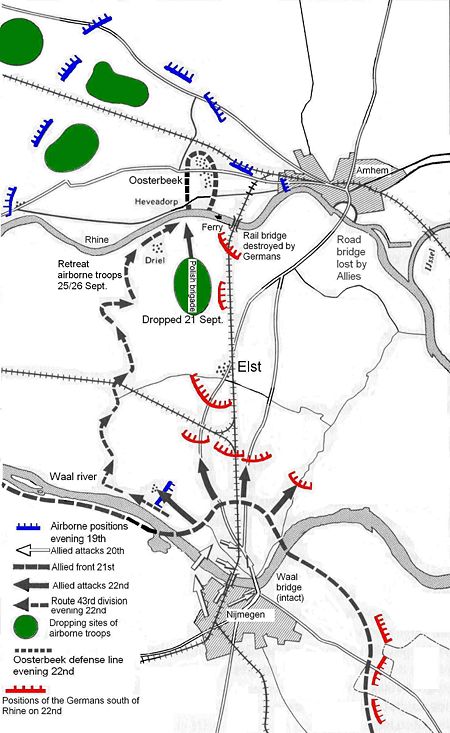Operation Market Garden: Difference between revisions
John Leach (talk | contribs) m (Text replacement - "101st Airborne Division" to "101st Airborne Division") |
John Leach (talk | contribs) (largely revised so that it passes review; needs to be expanded using sourced information which I have; adding this to my to-do list) |
||
| Line 1: | Line 1: | ||
{{subpages}} | {{subpages}} | ||
{{Image|Battle of Arnhem.jpg|right|450px|The "Battle of Arnhem" was mainly about the possession of two road bridges: at Nijmegen (conquered by the Allied forces) and Arnhem (held by the Germans)}} | {{Image|Battle of Arnhem.jpg|right|450px|The "Battle of Arnhem" was mainly about the possession of two road bridges: at Nijmegen (conquered by the Allied forces) and Arnhem (held by the Germans)}} | ||
'''Operation Market Garden''', implemented by the Allies in World War II, was an unsuccessful to seize bridges over the [[Meuse River|Meuse]], [[Waal River|Waal]] and [[Rhine River|Rhine]] rivers in the German-occupied Netherlands. The Maas and Waal crossings were necessary pre-requisites for land-based forces to move forward, but the critical targets were the rail and road bridges over the Rhine at [[Arnhem]]. The name "Market Garden" reflected two major sub-operations: Market was the actual parachute and glider landings by the three divisions (British 1st Airborne Division, U.S. 82nd and 101st Airborne Divisions) and one Polish brigade of the First Allied Airborne Army; Garden was the linkup by XXX Armoured Corps. | |||
The operation began in the evening of 17 September 1944 when airborne troops were dropped into a landing zone west of Arnhem. They encountered strong German resistance. This was unexpected as Allied Command were unaware that a [[Waffen SS]] armoured corps had been posted to the area for rest and relaxation. The Germans blew the rail bridge but, despite a fierce assault by the Allied troops, managed to hold the rail bridge. The Allies had hoped to capture the road bridge in a single rush soon after landing, as they had done at the Pegasus Bridge on D-Day. However, as Arnhem is a large town, the drop zones were a long way from the bridge and the Germans had time to organise their defence. Meanwhile, the advancing British land force had captured the Meuse and Waal crossings. Many Allied troops were taken prisoner in Arnhem and the battle ended after the rest retreated on 25 and 26 September. | |||
All accounts praise the British forces who fought at Arnhem, but they had to advance from unfavourable positions against much stronger resistance than anticipated. Eventually, the 1st Airborne splintered and several units were obliged to surrender after fighting overwhelming odds. Other units, and many individuals, managed to escape across the Rhine and reach safety at Nijmegen. | |||
==References== | |||
{{reflist}} | |||
[[Category:Reviewed Passed]] | |||
Revision as of 04:39, 10 March 2024
Operation Market Garden, implemented by the Allies in World War II, was an unsuccessful to seize bridges over the Meuse, Waal and Rhine rivers in the German-occupied Netherlands. The Maas and Waal crossings were necessary pre-requisites for land-based forces to move forward, but the critical targets were the rail and road bridges over the Rhine at Arnhem. The name "Market Garden" reflected two major sub-operations: Market was the actual parachute and glider landings by the three divisions (British 1st Airborne Division, U.S. 82nd and 101st Airborne Divisions) and one Polish brigade of the First Allied Airborne Army; Garden was the linkup by XXX Armoured Corps.
The operation began in the evening of 17 September 1944 when airborne troops were dropped into a landing zone west of Arnhem. They encountered strong German resistance. This was unexpected as Allied Command were unaware that a Waffen SS armoured corps had been posted to the area for rest and relaxation. The Germans blew the rail bridge but, despite a fierce assault by the Allied troops, managed to hold the rail bridge. The Allies had hoped to capture the road bridge in a single rush soon after landing, as they had done at the Pegasus Bridge on D-Day. However, as Arnhem is a large town, the drop zones were a long way from the bridge and the Germans had time to organise their defence. Meanwhile, the advancing British land force had captured the Meuse and Waal crossings. Many Allied troops were taken prisoner in Arnhem and the battle ended after the rest retreated on 25 and 26 September.
All accounts praise the British forces who fought at Arnhem, but they had to advance from unfavourable positions against much stronger resistance than anticipated. Eventually, the 1st Airborne splintered and several units were obliged to surrender after fighting overwhelming odds. Other units, and many individuals, managed to escape across the Rhine and reach safety at Nijmegen.
